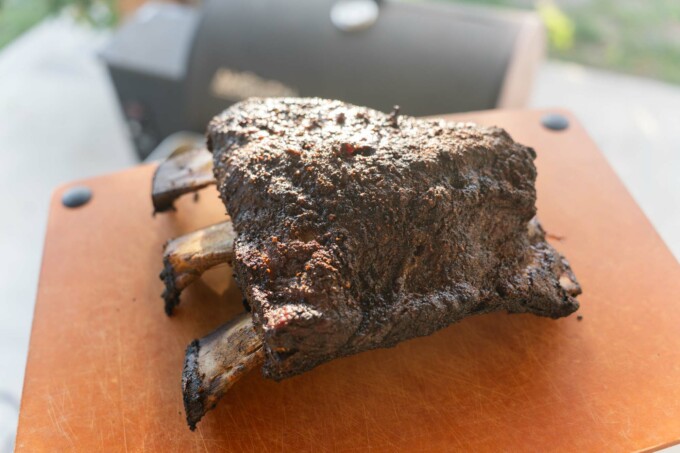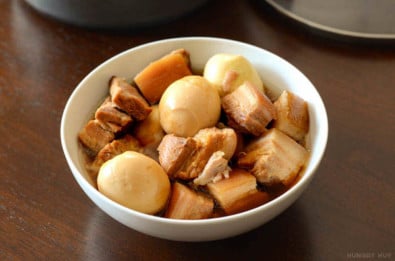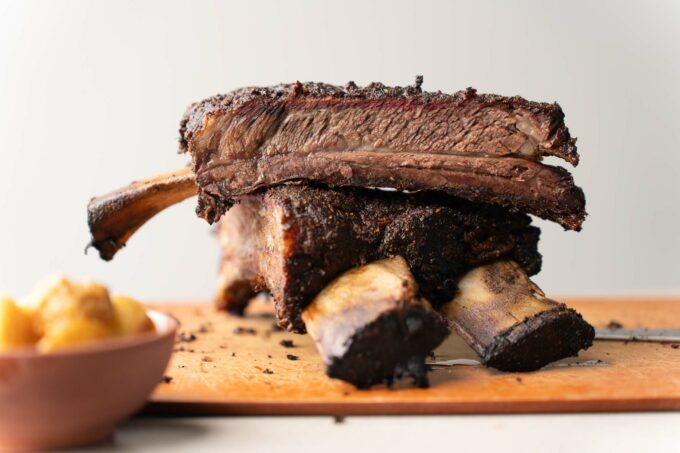
If there’s one thing for sure, I will always order a beef rib at BBQ spots I visit, like Heritage Barbecue in Southern California or Green Street Smoked Meats in Chicago. This cut of smoked meat has a huge dinosaur-like bone and is so tender and juicy. Beef ribs at these spots range from $35-$48 per pound, so that means one rib is typically $60-75.
But if you’re trying to throw down on the smoker at home, you can also make smoked beef ribs for about $20-$30 per rib. Learn how to pick the proper cut of beef rib and how to properly marinate and smoke the most tender beef ribs at home.
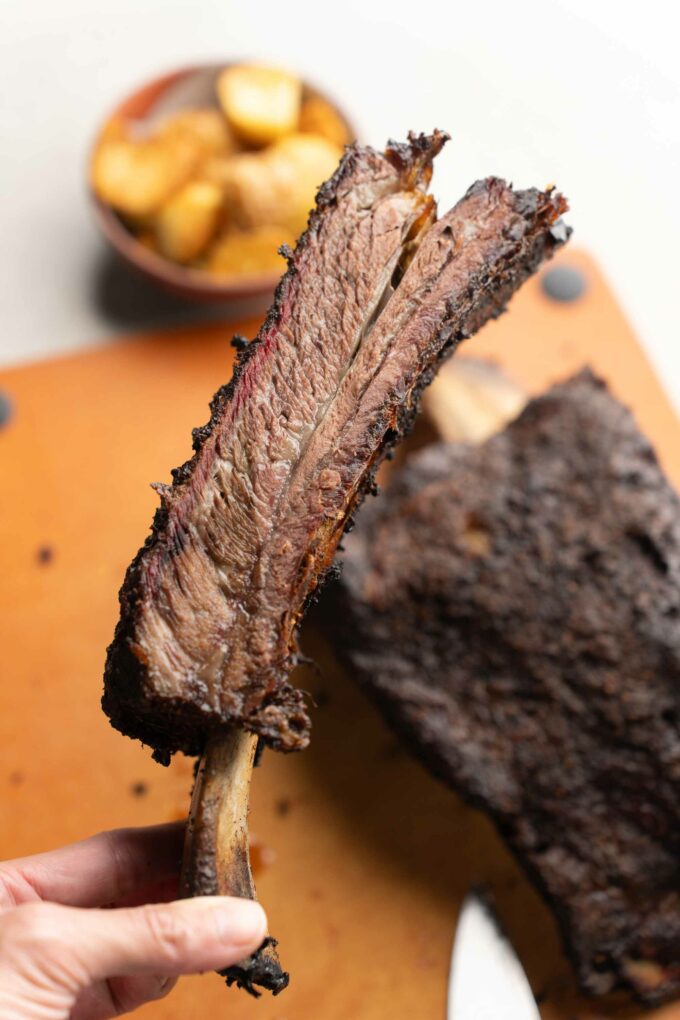
Beef plate ribs vs short ribs
When I first started smoking beef ribs, I was confused by the many different cuts of beef ribs you can buy. Here is a breakdown of what you can expect to see at the butcher or grocery store:

- Plate ribs: Also known as plate short ribs, beef plate ribs are the ideal cut of meat for smoking because they have a more significant piece of meat on the bones. They typically have three huge pieces of bones attached and are sometimes referred to as dino ribs. Finding plate ribs took more work than other cuts. I found these at Wild Fork and our local butcher; however, you can order them online. Plate ribs should be labeled appropriately on the package.
- Chuck ribs: I found chuck ribs more readily available, and they often have four bones attached with a thinner piece of meat on top. If I can’t find plate ribs, these would be my backup. Chuck ribs are also more readily known as general short ribs at many grocery stores.
- Beef back ribs: Do not buy beef back ribs for this recipe because they are typically thinner and have less than one inch of meat. Back ribs are better for braising and stews.
What temperature to smoke beef ribs?
I smoke beef ribs at 250 °F for this recipe and cook them for about four to five hours for a five-pound beef plate. While some smoke pros like Aaron Franklin go up to 285 °F on his larger commercial smokers, he recommends lowering it to 250 °F for home cooks with residential-level smokers. Smoking beef ribs at 250 °F will give you an even cooking heat, thick bark, and juicy meat.
For beef ribs, I like to use hickory, oak, or mesquite pellets because they pair well with the stronger flavor of beef. However, I have previously used pecan pellets (best for poultry like smoked turkey legs) for beef ribs, and it was still good, even if the smokiness wasn’t as pronounced. To learn more about the best wood for smoking, read my post here.
What temperature are smoked beef ribs done?
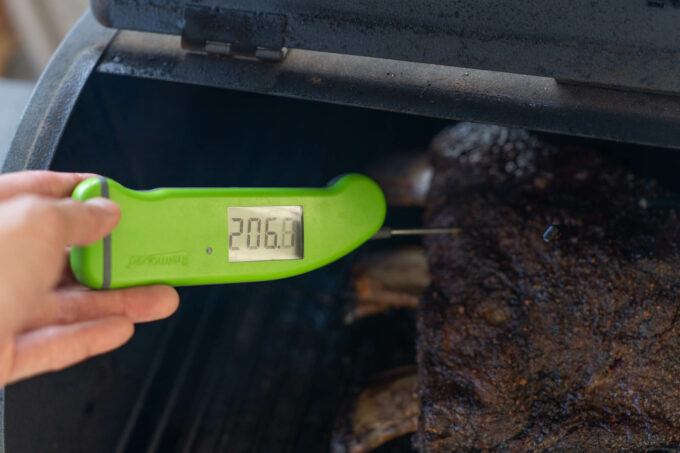
Smoke the beef ribs until they reach 205 °F internally at the thickest part of the beef plate. Use an instant-read internal thermometer to measure the temperature of the beef ribs throughout smoking. While meat is safe to consume at 145 °F, you can continue to cook the beef ribs to 205 °F without fear of overcooking them because this part of the animal has so much collagen and fat.
The collagen and fat are rendered down during prolonged cooking at a higher temperature to produce melt-in-your-mouth pieces of meat. These temperatures are typically higher than what the USDA requires for cooking meat because you need to cook the meat down longer to break down the collagen and fat. When you remove the ribs from the smoker, let it rest for at least 20 minutes so you don’t lose any juices inside the meat.
How long does it take to smoke beef ribs?
The length of smoking time for beef ribs depends on the size of the beef plate you’re cooking. Smoking beef ribs at 250 °F takes around 1-1 ½ hours per pound of meat. So, it took me almost five hours for a five-pound beef plate.
Obviously, this changes depending on your piece of meat, and I would heavily recommend using a thermometer to track your meat’s doneness. I like using a wireless probe thermometer so I can check the progress on my phone app. Once it hits 205 °F, the fat and collagen on the meat should be fully rendered, leaving you with tender and moist ribs.
Beef rib rub ingredients

I use a homemade beef rub consisting of
- freshly ground black pepper
- kosher salt
- dark brown sugar
- mustard powder
- garlic powder
- cayenne
You are open to use whatever you have at home or make your own based on your preferences, but note that it might taste different. For less spice, you can switch cayenne for smoked paprika. You can add other popular beef rub seasonings like onion powder, chili powder, or herbs like oregano or basil. This recipe is similar to my rub for Traeger smoked chicken thighs.
Should I spray beef ribs while smoking?
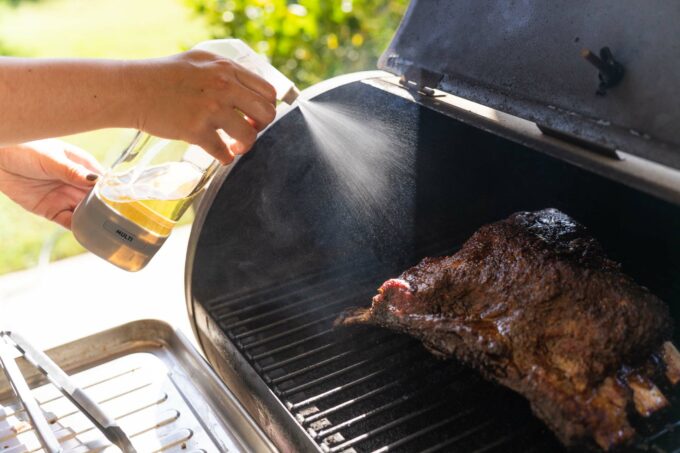
To prevent the beef ribs from drying out during smoking, make a mop spritz made of one part apple cider vinegar and three parts water. I like to use a spritz bottle to spray the beef rib down every hour after the first two-hour mark.
Do you smoke beef ribs bone up or down?
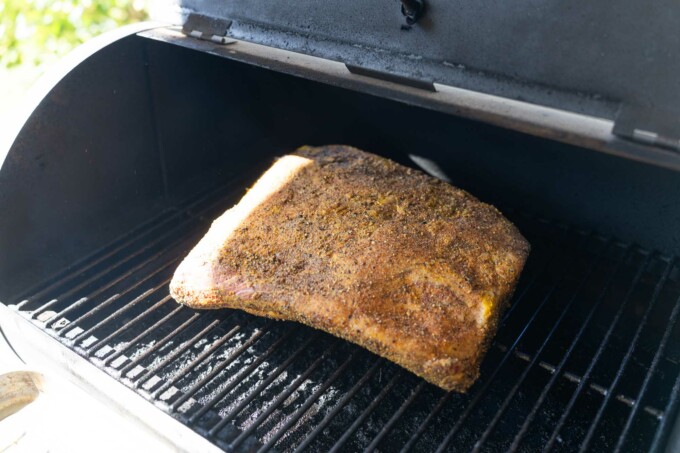
Place the beef ribs bone up so that the portion with the most meat is on top and the membrane touches the smoker grates. (This is similar to the position of smoked turkey breast). This helps create a better bark on the surface of the meat. Once you place the ribs on the grates, you don’t need to move them during smoking.
What are the best methods for cooking beef ribs?
There are so many methods to cook beef ribs, depending on the recipe and cut of beef you have. Chuck ribs and beef ribs are good options for braising for a stew, but many people also like baking short ribs for easy cooking. However, note that you cannot produce a bark on the skin’s surface like a smoking can or a smoke ring around the meat. Because plate ribs have such a high-fat content, they are also great in Dutch oven braises or slow cookers.
If you want another take on ribs, 3-2-1 ribs are made of pork and have a different texture and consistency than beef ribs. Where beef ribs are ultra-tender and have a thick bark crust, 3-2-1 pork ribs are wrapped for two hours and have a slight al dente texture.
How do you keep beef ribs moist?

While beef rib cuts like chuck ribs or plate ribs have a lot of collagen and fat and take a while to overcook, I recommend smoking them low and slow at 250 °F. While some people prefer wrapping ribs with butcher paper throughout the smoking period, I don’t like this because it prevents creating a bark on the surface of the meat. I’ve smoked beef ribs without the butcher paper, and the insides were still tender and juicy.
Another recommendation is using a built-in thermometer to measure the temperature of the beef ribs. Monitoring this frequently will tell you when the internal temperature reaches 205 °F and prevent overcooking.
For more smoker ideas check out my recipes:
- smoked salmon
- smoked turkey breast
- smoked chicken thighs
- best wood for smoking
- pork baby back ribs
- smoked turkey legs
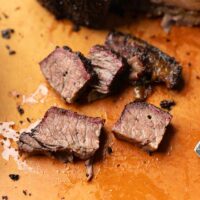
Smoked Beef Ribs
Ingredients
- 5 lb plate beef rib
- yellow mustard
Rub seasoning
- 3 tbsp ground black pepper
- 1 tbsp kosher salt
- 1 tbsp dark brown sugar
- 2 tsp mustard powder
- 2 tsp garlic powder
- 1 tsp cayenne
Mop
- ¾ c water
- ¼ c apple cider vinegar
Equipment Used
- smoker
- wood pellets or logs
- tongs
- sheet pan
- cooling rack
- Foil
- spray bottle
- measuring spoons and cups
- knife
Instructions
- Remove extra fat or silverskin on top of the beef plate. There should be relatively no large fat chunks on the top of the beef plate. Leave the membrane on the back of the ribs to keep them from separating during smoking.
- Combine all the rub seasoning ingredients until incorporated.
- Coat the beef plate with a light layer of yellow mustard.
- Cover the entirety of the beef plate with the rub seasoning.
- Place the beef plate on a sheet pan and cover with foil. Place this in the fridge for at least 8 hours and up to 24 hours. When ready to cook, remove the beef plate from the fridge and place it on the counter for about 2 hours to come to room temperature.
- Preheat the smoker to 250 °F.
- Place the beef plate into the smoker. At 2 hours, check the internal temperature and texture.
- Spritz the beef plate with the mop mix and check continually every hour.
- Remove the beef plate when it reaches an internal temperature of 203-207 °F and the bark looks dark and feels hard. Use the probe to check the texture of the meat, it should feel soft inside and slide easily.
- Let rest for 30 minutes on the counter.

